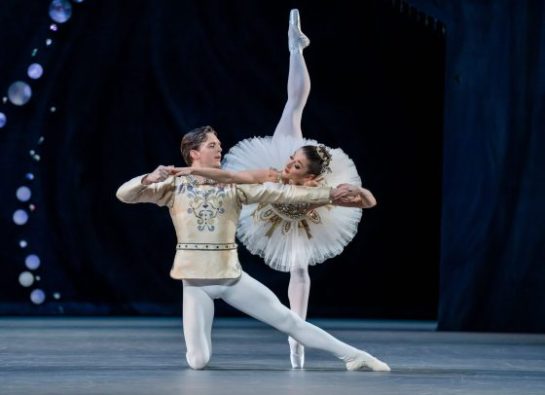 United Kingdom George Balanchine’s Jewels: Dancers of The Australian Ballet, Royal Ballet Sinfonia / Jonathan Lo (conductor). Royal Opera House, London, 2.8.2023. (JO’D)
United Kingdom George Balanchine’s Jewels: Dancers of The Australian Ballet, Royal Ballet Sinfonia / Jonathan Lo (conductor). Royal Opera House, London, 2.8.2023. (JO’D)

Choreography – George Balanchine
Music – Emeralds: Fauré, extracts from Pelléas et Mélisande and Shylock
Rubies: Stravinsky, Capriccio for Piano and Orchestra, Op.29
Diamonds: Tchaikovsky, Symphony No.3 in D Major
Dancers – Principal Artists, Senior Artists, Soloists, Coryphées and Corps de Ballet of The Australian Ballet
After an interval of thirty-five years, The Australian Ballet returns to the stage of the Royal Opera House in George Balanchine’s Jewels (1967). A Jewels with the original set designs by Peter Harvey recreated by the designer himself. Behind the dancers in this production are whole Milky Ways of emeralds, rubies, diamonds. These compete with the jewels on the costumes, and even with the dance. But for their strength, musicality and precision, the dancers of The Australian Ballet manage to hold the attention.
In Emeralds, to music by Gabriel Fauré, the women wear long tutus of pale green. They resemble the sylphs in La Sylphide. In the opening section, a male dancer (Callum Linnane) moves among them like the bemused hero of that Romantic ballet. The angular choreography of Rubies, like the Stravinsky Capriccio for Piano and Orchestra to which it is set, refers to the Jazz Age. The stateliness and grandeur of Diamonds, to four movements from Tchaikovsky’s Symphony No.3 in D Major, recreate the late-nineteenth century ballet in St Petersburg that Balanchine knew at first hand.

Diamonds gives you the double pleasure of Balanchine and a nearly complete Tchaikovsky symphony expressively played by the Royal Ballet Sinfonia and idiomatically conducted – as all the music was – by Jonathan Lo. It also contains the surprise that the assured dancer who looks like Joseph Caley is Joseph Caley. (He joined The Australian Ballet from English National Ballet in 2022.) Rubies has its flexed hands, its projecting hips, its wit, and the really remarkable pairing of Ako Kondo and Brett Chynoweth as the First Principal Couple. Emeralds, delicate and slower-paced, outshone in lots of ways by the ballets that follow, is a dance to the music of time with an ending that can send a shiver down the spine.
In her programme note, dance writer Marina Harss finds a thread that connects the three ‘seemingly unrelated’ parts of Jewels: ‘a belief in the unattainability of women.’ The standing ballerina (Benedicte Bemet) at the climax of Diamonds allows her kneeling partner to kiss her hand. In the final tableau she stands beside him, not supported by him in a lift. The soloist in Rubies (Isobelle Dashwood) teases four men with her legs and hips but appears to reject them all. And there is no other suitor, no need for one, as there is for Aurora after she rejects the four princes in The Sleeping Beauty.
While the principal women in Emeralds (Sharni Spencer and Valerie Tereshenko) have partners, they both dance variations that show a self-absorbed apartness. If Balanchine had not expressed his dislike of Isadora Duncan, you could believe he was thinking of her. And in this ballet, where arms and legs can move like the hands of a clock, where exits are somehow more significant than entrances, there is also a concern with the apartness of death. In the coda that Balanchine added to the ballet in 1976, three men suddenly find themselves alone on the stage. ‘Jack hath not Jill’, as Biron says at the end of Shakespeare’s Love’s Labour’s Lost. Nine years after choreographing to Tchaikovsky’s Third Symphony, Balanchine may have been thinking of the ending to that composer’s Sixth.
John O’Dwyer
